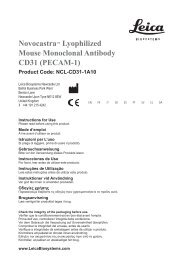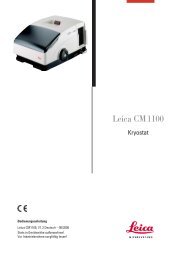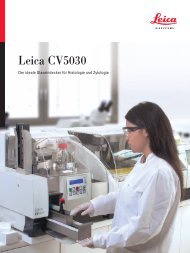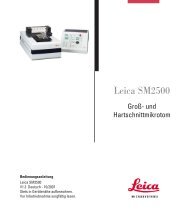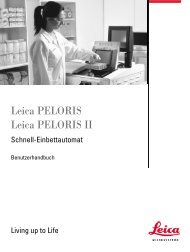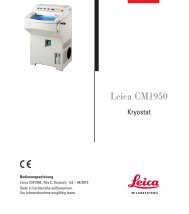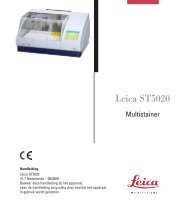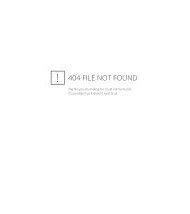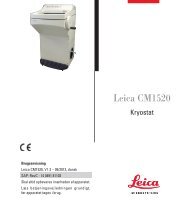Info - Leica Biosystems
Info - Leica Biosystems
Info - Leica Biosystems
Create successful ePaper yourself
Turn your PDF publications into a flip-book with our unique Google optimized e-Paper software.
•<br />
•<br />
PA0171 Rev A<br />
Page 3<br />
Minimize microbial contamination of reagents or an increase in non-specific staining may occur.<br />
Retrieval, incubation times or temperatures other than those specified may give erroneous results. Any such change must be<br />
validated by the user.<br />
Instructions for Use<br />
CD21 (2G9) primary antibody was developed for use on the automated Bond system in combination with Bond Polymer Refine<br />
Detection. The recommended staining protocol for CD21 (2G9) primary antibody is IHC Protocol F. Heat induced epitope retrieval is<br />
recommended using Bond Epitope Retrieval Solution 2 for 20 minutes.<br />
Results Expected<br />
Normal Tissues<br />
Clone 2G9 stained the CD21 protein in follicular dendritic cells (FDCs) of lymphoid tissue and mature B cells. It strongly labelled FDCs<br />
in 29/29 cases of tonsil, with a dense meshed FDC network in the light zone and a more loosely arranged, weaker staining pattern of<br />
staining in the dark zone. The staining of mantle zone B cells was faint and much less consistent. The staining of the FDC network was<br />
also seen in 5/5 cases of spleen. FDC staining was also evident in 2/4 cases of thyroid, 2/2 cases of cervix, 3/4 cases of stomach and<br />
3/4 cases of colon. The occasional mononuclear cell was labelled in other normal tissues tested. There was some weak staining of<br />
Leydig cells in testis no additional staining was observed in cases of uterus, placenta, prostate, ovary, pancreas, lung, liver, skin, breast,<br />
heart, small intestine, brain, pituitary and adrenal (n = 200).<br />
Tumor Tissues<br />
With clone 2G9, in follicular lymphoma (n = 3) the atretic follicles exhibited strong, well-defined FDC networks. In the larger abnormal<br />
follicles a more diffuse and less intense staining of FDCs was observed. No expression of CD21 was observed in the neoplastic cells<br />
of T-cell lymphoma (n=6) other than a few residual follicles showing strong FDC staining. No staining of neoplastic cells was observed<br />
in non-Hodgkin’s B-cell lymphoma (n = 14), lymphoblastic lymphoma (n = 2), Hodgkin’s disease (n = 4) or a range of additional tumors<br />
(n=26).<br />
CD21 (2G9) is recommended for the immunodetection of normal and abnormal cell expression of CD21 in follicular dendritic cells.<br />
Product Specific Limitations<br />
CD21 (2G9) has been optimized at <strong>Leica</strong> <strong>Biosystems</strong> for use with Bond Polymer Refine Detection and Bond ancillary reagents.<br />
Users who deviate from recommended test procedures must accept responsibility for interpretation of patient results under these<br />
circumstances. The protocol times may vary, due to variation in tissue fixation and the effectiveness of antigen enhancement, and must<br />
be determined empirically. Negative reagent controls should be used when optimizing retrieval conditions and protocol times.<br />
Troubleshooting<br />
Refer to reference 3 for remedial action.<br />
Contact your local distributor or the regional office of <strong>Leica</strong> <strong>Biosystems</strong> to report unusual staining.<br />
Further <strong>Info</strong>rmation<br />
Further information on immunostaining with Bond reagents, under the headings Principle of the Procedure, Materials Required,<br />
Specimen Preparation, Quality Control, Assay Verification, Interpretation of Staining, Key to Symbols on Labels, and General Limitations<br />
can be found in “Using Bond Reagents” in your Bond user documentation.<br />
Bibliography<br />
1. Clinical Laboratory Improvement Amendments of 1988, Final Rule 57 FR 7163 February 28, 1992.<br />
2.<br />
3.<br />
4.<br />
5.<br />
6.<br />
Villanova PA. National Committee for Clinical Laboratory Standards (NCCLS). Protection of laboratory workers from infectious<br />
diseases transmitted by blood and tissue; proposed guideline. 1991; 7(9). Order code M29-P.<br />
Bancroft JD and Stevens A. Theory and Practice of Histological Techniques. 4th Edition. Churchill Livingstone, New York. 1996.<br />
Kojima M, Nakamura S, Shimizu K, et al. Classical Hodgkin lymphoma occurring in clusters of nodal marginal zone<br />
B-lymphocytes in association with progressive transformation of germinal center. Pathology Research and Practice. 2003;<br />
199:547–550.<br />
Kojima M, Nakamura S, Motoori T, et al. Primary marginal zone B-cell lymphoma of the lymph node resembling plasmacytoma<br />
arising from a plasma cell variant of Castleman’s disease. A clinicopathological and immunohistochemical study of seven patients.<br />
Acta Pathologica, Microbiologica et Immunologica Scandinavica (APMIS). 2002; 110:875–880.<br />
Dupin N, Fisher C, Kellam P et al. Distribution of human herpesvirus-8 latently infected cells in Kaposi’s sarcoma, multicentric<br />
Castleman’s disease, and primary effusion lymphoma. Proceedings of the National Academy of Sciences USA. 1999; 96(8):<br />
4546–4551.<br />
ProClin 950 is a trademark of Supelco, a part of Sigma-Aldrich Corporation.<br />
Date of Issue<br />
17 April 2008



